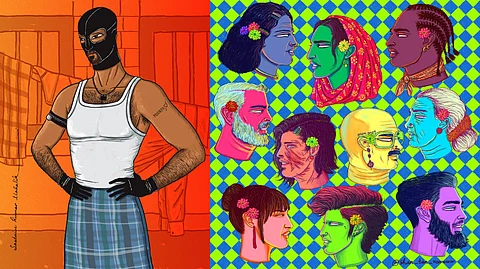
- HOMEGROWN WORLD
- #HGCREATORS
- #HGEXPLORE
- #HGVOICES
- #HGSHOP
- CAREERS
- ABOUT US
- CONTACT US

There's an Italian guy named Tavo on TikTok who got popular by painting himself fully in red body paint. That's all. That's his thing: a red man with some alt streetwear frolicking around. And despite the simplicity of the concept, it's beautiful to see a red man existing in our world; very much like us but not really. In the experience of perceiving Tavo, there comes awe and fascination for someone that's different from us. It's the same awe that many sci-fi films have created in narratives exploring the extraterrestrial instead of others that operate on the central theme of fear. The fear of the unknown or the ‘other’. In his illustrations, Delhi-based artist Santanu Kumar Mahalik tries to bring that same gaze of awe when looking at people who are a little different from us.
His characters are created leaning towards androgyny, defying conventional notions of gender and identity. But they are very much based on real people who do not subscribe to the binaries. Brimming with cultural references and contemporary aesthetics, his colourful characters capture the diverse gender expressions and identities of modern India.
The artist is able to create a gaze of awe for his characters from a deeply personal space in his psyche. In his youth, he was often bullied for being more effeminate than others. Through his characters, Santanu creates a space for himself that he was never allowed in; a space that paints diversity as a good thing. His illustrations boast characters with a variety of skin tones, body types and gender expressions. His commitment to creating an inclusive space in his art isn't limited to self-expression but also extends to self-acceptance.
Santanu's artistic journey is deeply personal. He experienced ostracisation in his youth and was bullied because of his appearance, which fuels his passion for inclusivity within his illustrations. His characters boast a kaleidoscope of skin tones, body types, and gender expressions, purposefully reflecting the beautiful diversity of the human experience. This commitment to inclusivity extends to his portrayal of individuals with vitiligo, disabilities, and survivors of acid attacks. Santanu believes that true beauty lies in embracing our differences, and his illustrations serve as a powerful counterpoint to societal prejudices; subverting the ‘othering’ gaze towards people who lead different lives.
Santanu's visual vocabulary thrives in merging two ends of different spectrums: the old with the new, traditional with contemporary, and local with global. He draws inspiration from India's rich cultural heritage, incorporating traditional motifs into his contemporary illustrations. This juxtaposition creates a sense of dynamism, where the past informs the present. For instance, he might use a classic paisley design reimagined in a bold colour palette, or incorporate intricate henna patterns; adorning a character with a modern haircut. My favourite has to be the BDSM/ Leather kink guy in a banyan and lungi. This juxtaposition also blends the unfamiliar with the familiar, making it more palatable conceptually in a way that cuts across the divide present in different social groups.
The artist's keen eye for fashion is evident in the sartorial choices of his characters. As a fashion student himself, he stays abreast of current trends through various sources, including social media platforms like Instagram, discussions with fellow creatives, and industry publications like Vogue and Harper's Bazaar. However, he doesn't merely follow trends; he incorporates his own style sensibilities and understands that personal fashion can be used as a social and political statement. His characters are often adorned in garments that blur the lines between masculinity and femininity, further emphasizing his rejection of rigid categorizations. Santanu doesn't shy away from using colour either. His illustrations reflect his personal love for bold hues, and this love of colour translates into the wardrobes of his characters.
Much like his characters, Santanu doesn't want to limit himself in his artistic expression. While adept at traditional mediums like pastels and acrylics, he is eager to experiment with animation, ceramic sculptures, and even costume design. His openness to new materials and techniques allows him to constantly evolve and push the boundaries of his artistic practice. The fact that he finds most of his inspiration in the world around him speaks to his diversity and dynamism. Rooted in social consciousness, Santanu’s art aims to shift our gaze from fear to that of awe when looking at someone different. It encourages us to embrace diversity as a function of individuality and evolution in humans rather than rejecting it.
Follow Santanu here.
If you enjoyed reading this, here's more from Homegrown:
Abhay Sehgal's Surrealist Art Ponders The Fears & Fantasies Of The Digital Age
Inside Ahmedabad's Aquatic Gallery: India's First Inland Aquarium
Sign Up For A Mumbai Workshop Aiming To Map The Emotional Landscapes Of Our Homes
